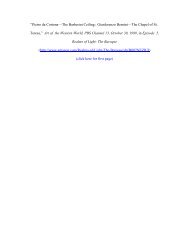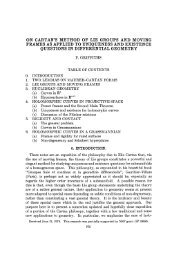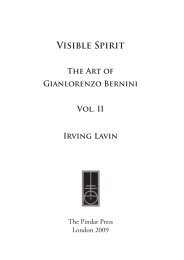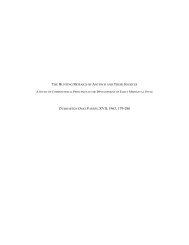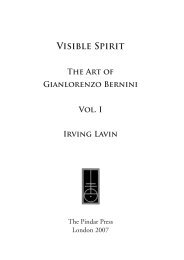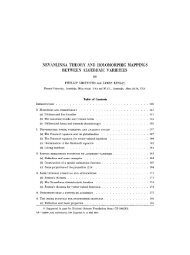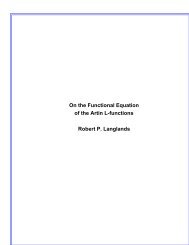View PDF - Project Euclid
View PDF - Project Euclid
View PDF - Project Euclid
You also want an ePaper? Increase the reach of your titles
YUMPU automatically turns print PDFs into web optimized ePapers that Google loves.
496 PHILLIP A. GRIFFITHS<br />
Footnotes<br />
1. We recall that for V W a surjective proper mapping of complex manifolds with generic<br />
fibre of dimension k, integration over the fibre gives a map<br />
with the defining property<br />
rr," Ac + k. + k)(V) Ac("q)(W)<br />
(4.2) q/ rr*) zr.Ik/ /, 1 A*(W).<br />
V W<br />
It follows that 7r. commutes with 0 and c5, and also preserves positive forms. We shall also have<br />
occasion to use integration over the fibre when V is singular, but the extension to these cases will be<br />
obvious.<br />
2. The point is that, by Schur’ lemma, any Hermitian form on s which is invariant under the<br />
unitary group must be a multiple of the standard one. As much more sophisticated use of invariant<br />
theory occurs in section 4(c) below--cf, the discussion pertaining to the reference cited in footnote<br />
10.<br />
3. cf. the reference given in footnote 5 of section 3.<br />
4. cf. footnote 11 in section for an argument which covers all the cases we shall use in this<br />
paper.<br />
5. Once we know that, by averaging, the deRham cohomology of G(n, N) is isomorphic to the<br />
cohomology<br />
--<br />
computed from the complex of invariant forms, the argument goes as follows: The<br />
invariant forms are exterior polynomials in the quantities to,, bv which are invariant under<br />
to, gto,vh,, where g and h are unitary matrices. Using the h’s, we deduce that only the<br />
expressions<br />
appear; in particular, the invariant forms are all of even degree. Using the g’s, any invariant form is<br />
a polynomial in the elementary symmetric functions of (II). By direct integration one finds that<br />
c(fE) is Poincar6 dual to<br />
6. cf. W. Stoll, Invariant Forms on Grassmann Manifolds, Annals of Math. Studies no. 89,<br />
Princeton University Press, (1977). The form r/F.a may also be constructed by applying standard<br />
potential theory to the Grassmannian to solve the equation of currents (ii).<br />
7. As we saw in (3.11), aside from a few special cases the Gaussian image y(M) may be expected<br />
to have dimension n.<br />
8. cf. footnote 2 in section 1.<br />
9. We note that V T0(s) * N, and W Tn(G(n, N)) n N-n,; cf. footnote<br />
3 in section 3.<br />
10. H. Weyl, The Classical Groups, Princeton University Press, 1939.<br />
11. In the reference cited in footnote 4) of section 2, cosets : and x are defined to be incident if gH<br />
and g’K have in common a left coset relative to H tq K. This notion is not sufficiently broad to<br />
cover the examples we have in mind.<br />
12. cf. the recent works, Gary Jensen, Higher Order Contact of Submanifolds ofHomogeneous<br />
Spaces, Lecture Notes in Math, no. 610, Springer-Verlag (1977); Mark Green, The moving frame,<br />
differential invariants, and rigidity theorems for homogeneous spaces, to appear in Duke Math. J.<br />
13. This means that C and C’ pass through x0 and have the same tangent line there.<br />
5. Curvature and Piiicker Defects<br />
(a) Gauss-Bonnet and the Pliicker paradox. To obtain an heuristic idea of




